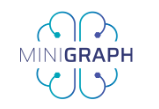Portfolio Activities
We are happy to being part of the EIC Challenge Tools to measure and stimulate activity in the brain tissue portfolio and actively participate in portfolio activities, including: participation in EIC conferences, workshops or any EIC Portfolio or networking meeting; experience and data sharing with other consortia and EIC stakeholders; participation in any relevant EIC Business Acceleration Services events.
We are joining forces across Europe to advance a new non-invasive technology – transcranial ultrasound stimulation (TUS) – to reversibly modulate brain regions with exquisite millimetre precision, even deep in the brain. As such, we aim to establish an urgently needed novel treatment option for neurological and psychiatric diseases. TUS combines the precision and reach of invasive deep brain stimulation, required to directly target clinically relevant structures, with the non-invasive and low-cost nature of transcranial electromagnetic techniques that are inherently limited in focus and depth. The main roadblock to widespread adoption of TUS in neuroscientific and clinical applications is the difficulty of steering the small ultrasound focus onto the intended target and reaching the desired intensity, with no empirical validation of targeting success currently available. We will develop a neuronavigated TUS-MRI system with advanced magnetic resonance imaging (MRI)-guided application planning and closed-loop application control to enable safe, individualised, and effective high-precision TUS in humans. As such we will unlock the full potential of TUS to non-invasively modulate deep brain structures with unprecedented spatial precision in the millimetre range. The final prototype will be a fully functional device that integrates novel MR-compatible 256-element TUS-transducers (for advanced 3D-steering of the TUS focus) with a custom-tailored 32-channel MR-receiver coil (for accelerated imaging with maximal sensitivity) and closed-loop target validation using MR-acoustic radiation force imaging (MR-ARFI). This novel device with its unique features will enable for the first time the personalized non-invasive high-precision stimulation of cortical and subcortical targets in the human brain. It will be a game changer for both neuroscientific research and clinical application in neurological and psychiatric diseases with the potential to benefit millions of patients.
Neurons communicate and carry out tasks via a complex interaction of signalling mechanisms including electrical, chemical (molecular and ionic) and thermal changes. Their participation in a given task can be measured in part by signals generated during their depolarisation and repolarisation, both individually and as the synchronous activity of many cells (extracellular field potentials). The ambitious EIC-funded CROSSBRAIN project will develop a swarm of wireless, implantable, MRI-compatible microbots that can sense electrical activity at the cellular and circuit levels and modulate electrical stimulation of cells, according to need. This will be accomplished with multimodal actuators supported by extreme edge computing made possible with onboard miniaturised wireless energy harvesting and communication.
Genome editing technologies based on CRISPR/Cas systems allow targeted genomic modification with unprecedented precision and have emerged as powerful alternatives to the conventional gene therapy approaches for various human diseases, with a series of clinical trials in progress. However, some crucial challenges remain to be addressed to enhance efficiency and safety and decrease costs of treatments. Current viral-based delivery systems are associated with high risk of toxicity and immunogenicity and remain highly expensive. We will develop a new generation of non-viral delivery systems for gene editing tools based on the use of modified nanoparticles with human-derived protein moieties that will allow targeting the tissue and cells of interest in vivo with minimal adverse effects. Prime editors have raised exciting possibilities for double-strand break free genome editing. However, a major limitation of current prime editors is highly variable efficiency both from one target to another and between cell types. We will design and evaluate novel prime editor tools in order to both increase activity per se and overcome cell-specific limitations.We will test our approach on the hematopoietic system to treat Sickle Cell Disease, avoiding the challenges and risks of hematopoietic stem cell manipulation associated with current gene therapy approaches, and thus providing a treatment much simpler, safer and cost-effective to implement. Our technological breakthroughs address two key obstacles in cell and gene therapy: gene editing efficiency and systemic delivery. The novel prime editors and targeted nanoparticles that we will engineer will be combined to make unprecedented off-the-shelf, recombinant biologics for gene therapy. The versatility of the design of these novel recombinant biologics makes them suitable for the treatment of a vast majority of genetic diseases.
Neuronavigation enables neurosurgeons to avoid functional brain locations when removing tumours, using computer-assisted technologies. However, the inability to maintain accurate spatial information on lesions intraoperatively remains a challenge for brain tumour surgeries. The EU-funded HyperProbe project will assemble an interdisciplinary team to develop an innovative optical intraoperative imaging system based on hyperspectral imaging (HSI) and artificial intelligence (AI), for image reconstruction and molecular fingerprinting. The novel HSI system will be handheld and user-friendly, applying AI-based algorithms for the analysis and quantification of images. The project aims to validate the developed technology in vivo, using gold standard modalities in neuronavigational imaging, and provide final proof-of-principle during brain tumour surgery.

High-dimensional electrical stimulation for visual prosthesis (HYPERSTIM)
Future advanced neuroprostheses, especially visual prostheses, will need to transfer much more information than currently possible. Improving the electrode count will be part of the solution. The EU-funded HYPERSTIM project will use the available electrodes more efficiently by applying sophisticated stimulation protocols. The project's main objective is to achieve a resolution of at least 20 times the number of electrodes that are physically present with a combination of techniques. The obtained order-of-magnitude improvement in resolution will spur the development of breakthrough prostheses that will be widely adopted by blind patients and bring the field of neural interfacing to the next level.
Locked-in syndrome is a rare and serious neurological disorder caused by damage to a part of the brainstem, which leaves a person totally paralysed but conscious and with normal cognitive abilities. This means they can see, hear and feel normally – even a fly on their nose, for example – yet they cannot move or speak. The psychological and emotional burden on patients and their caregivers is tremendous. The EU-funded INTRECOM project is developing a pioneering, fully implantable AI-based brain-computer interface to address this. It will enable real-time decoding of a person’s intended speech, and automatic transmission to receiving equipment in a bid to unlock the potential of these patients to communicate.








